How to Create a Successful PPC Campaign Strategy to Captivate Your Audience
Have you ever wondered how those successful PPC campaigns really work? You’re not alone. With the kind of potential PPC Ads have to generate amazing results, it is no wonder every marketer and business alike wants to know the ins and outs of what makes a PPC campaign successful.
Simply put, a PPC campaign, or Pay-Per-Click campaign, is an effective online advertising strategy to ensure your ads reach the right audience at the right time. Therefore, if done correctly, PPC campaigns can be a fast and effective way to get remarkable results.
So, are you ready to turn those clicks into conversions?
Let’s dive in and equip you with the skills to set up a winning advertising campaign. In this guide, we’re going to explain what a PPC campaign is, why it’s important, and most importantly, how to create one that can get you the desired results.
By the end of it, you’ll not only understand the basics but also be ready to launch a PPC campaign that takes your business to the next level.
What is a PPC Campaign?
A PPC campaign, which stands for pay-per-click campaign, is a type of online advertising where you pay a fee each time someone clicks on your ad. It’s like putting up a sign on a busy street corner, but instead of paying for the space, you only pay when someone actually stops and reads your sign.
Why Should You Invest in PPC Campaigns?
Here’s why PPC campaigns are important:
Reach the right people
Unlike traditional advertising, like TV or billboards, PPC lets you target your ads to the exact people you want to reach. This means you’re not wasting money showing your ads to people who don’t care about your product or service.
Get fast results
When you need to get the word out quickly, PPC is the way to go. You can launch a campaign and start seeing results in minutes or hours. This is especially helpful for promoting time-sensitive offers or events.
Level the playing field
Even small businesses can compete with big companies with PPC. You don’t need a huge marketing budget to get your ads seen by potential customers. Just set a budget that works for you and start bidding on relevant keywords.
Control your costs
You only pay when someone clicks on your ad, which means you’re not wasting money on impressions (when people just see your ad but don’t click on it). This gives you more control over your advertising budget and helps you make the most of your investment.
Steps for Creating a Successful PPC Campaign Strategy
1. Define Your Goals and Objectives
Getting your PPC campaign off the ground starts with defining clear goals. Before diving into keywords and ad formats, take a moment to answer: What do you want to achieve? Whether it’s boosting sales, driving website traffic, or enhancing brand awareness, outlining specific objectives will help you create a successful campaign.
Tip: Make sure your goals are specific, measurable, achievable, relevant, and time-bound (SMART) and align with the company objectives. This framework will guide you in the right direction as you work through the intricacies of PPC.
2. Understand Your Audience
Creating successful PPC campaigns requires more than just defining goals—it involves knowing your audience inside and out. Here’s how to do it:
2.1 Define Your Target Audience
Before you can reach your audience effectively, you need to know who they are. Take time to identify and understand your target audience. What drives their interests, influences their behaviors, and aligns with their preferences?
The more insights you gather, the more adeptly you can customize your PPC strategy to truly resonate with them. This understanding becomes the cornerstone for crafting PPC campaigns that speak directly to the heart of your audience.
2.2 Utilize Buyer Personas
To ensure precise targeting, there’s a powerful tool in your arsenal that can get you the desired results, which is – A detailed buyer persona. These fictional characters represent your ideal customers, offering insights into their motivations and challenges.
Leveraging buyer personas grants you a unique perspective, enabling you to tailor PPC campaigns that captivate your audience and drive meaningful engagement.
Factors to Consider When Creating Buyer Personas
- Demographic Information:
Includes their age, gender, location, income level, and education. - Job Role and Responsibilities:
Understand their professional roles and responsibilities relevant to your offerings. - Challenges and Pain Points:
Identify the problems or challenges your audience faces that your product or service can address. - Goals and Aspirations:
Determine the goals and aspirations of your audience, both personal and professional. - Behavioral Patterns:
Analyze online and offline behaviors, including preferred communication channels. - Buying Motivations:
Explore the reasons that drive their purchasing decisions.
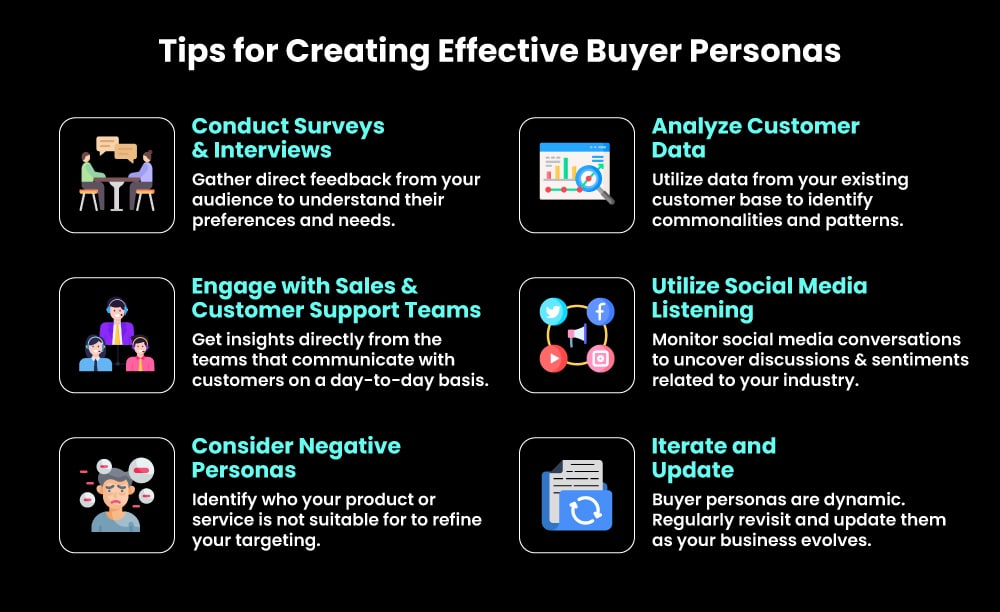
Creating buyer personas is an ongoing process that evolves with your business and industry changes. It’s a crucial step in ensuring your PPC campaigns are finely tuned to resonate with your target audience.
Also read: Win Over Your Customers With These 7 Customer Persuasion Techniques
2.3 Customizing Campaigns Based on User Behavior and Preferences
Behavioral Targeting:
Leverage behavioral targeting to reach users based on their online actions. This could include past purchases, website visits, or engagement with specific content. Tailor your PPC campaigns to align with these behaviors for a more personalized approach.
User Preferences:
Consider user preferences when crafting your PPC campaigns. If your audience responds well to visual content, focus on engaging graphics. If they prefer concise messaging, prioritize impactful copy.
Dynamic Ads:
Embrace dynamic ads that automatically adjust content based on user behavior and preferences. These ads dynamically display products or content that aligns with what the user has shown interest in, enhancing relevance.
Personalization:
Personalize your PPC campaigns for different segments. Craft variations of ad copy and visuals that resonate with specific demographics, interests, or behaviors. The more personalized your approach, the more likely users are to engage.
Setting up your PPC campaigns for success involves a nuanced understanding of your target audience and the strategic application of targeting options. By customizing your PPC campaigns based on user behavior and preferences, you create a dynamic and effective PPC strategy that resonates with your audience.
3. Keyword Research
Finding the right keywords is one of the most important building blocks of ensuring the success of your advertising campaigns. Before you launch your PPC campaign, understand this: thorough keyword research is the key to everything.
It’s not just about guessing what people might type into a search bar; it’s about diving deep into what your audience is actually looking for.
3.1 Long-Tail Keywords and Their Role in Targeting Specific Audiences
Don’t underestimate the power of long-tail keywords. While short and generic terms might attract a broad audience, long-tail keywords refine your reach, targeting users with specific needs. They might have lower search volumes, but their conversion potential is often higher.
3.2 Factors for Selecting Keywords
Choosing the right keywords for your PPC campaigns involves more than just relevance. Consider factors like cost, competitiveness, and search volume. Striking the right balance ensures your PPC strategy is both effective and efficient.
3.3 Tools for Conducting Effective Keyword Research
- Google Keyword Planner
- SEMrush
- UberSuggest
- Ahrefs
- Moz Keyword Explorer
- AnswerThePublic
- SpyFu
- KeywordTool.io
- KWFinder
3.4 Impact of Negative Keywords on PPC Campaigns
When it comes to crafting successful PPC campaigns, the negatives become the positives. Optimizing your PPC campaigns for negative keywords helps to refine your targeting, ensuring your ads don’t show up for irrelevant searches.
4. Create Compelling Ad Content and Graphics
4.1 Write Persuasive Ad Copy
Crafting ad copy is an art that combines brevity with impact. Here are strategies to ensure your ad copy not only captures attention but persuades your audience effectively:
Strategies for Crafting Concise and Compelling Ad Copy
- Clarity is Key:
Keep your message clear and concise. Avoid jargon and unnecessary details. Your audience should grasp the essence of your offer at a glance. - Highlight Benefits:
Focus on the benefits your product or service offers. How does it solve a problem or improve the user’s life? Clearly articulate these advantages in your ad copy. - Create Urgency:
Instill a sense of urgency to encourage prompt action. Limited-time offers exclusive deals, or seasonal promotions can motivate users to act quickly. - Call-to-Action (CTA):
Craft a compelling CTA that prompts users to take the desired action. Whether it’s making a purchase, signing up, or downloading, ensure your CTA is enticing and clear.
Also read: 5 Effective Tips for Writing Compelling Ad Copy
4.2 Craft Attention-Grabbing Headlines
In the fast-scrolling world of online content, your headline is your first and often only chance to make an impression. Remember, your headline is the gateway to your content. Make it an irresistible invitation that your audience can’t help but accept.
Here’s how to craft headlines that not only stop the scroll but also leave a lasting impact: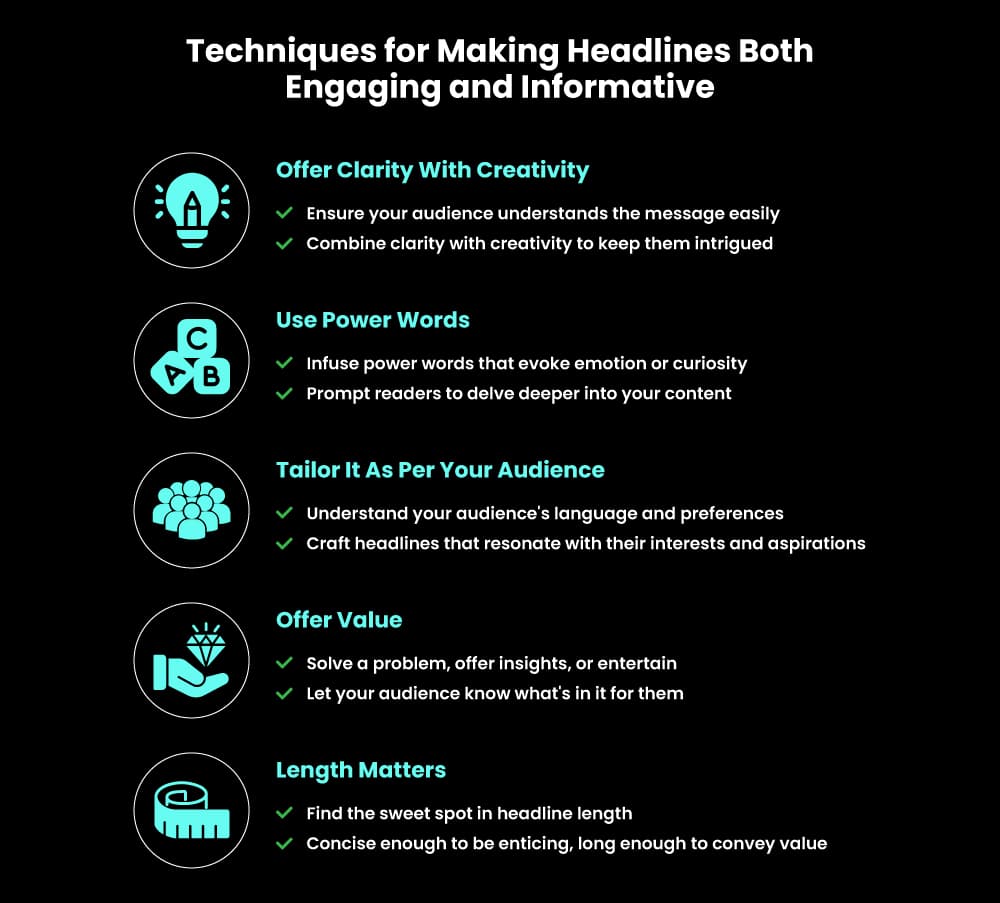
4.3 Utilize Storytelling and Emotion to Resonate with Your Audience
Beyond features and benefits, emotion and storytelling add depth to your ad copy, fostering a connection with your audience. Here’s how to infuse your copy with a compelling narrative:
Create Relatable Characters:
Introduce characters or scenarios that your audience can relate to. This helps in establishing an emotional connection, making your ad more memorable.
Highlight Real-Life Stories:
Share real-life stories or testimonials that showcase how your product or service has positively impacted customers. Authenticity goes a long way in building trust.
Evoke Emotion:
Identify the emotions you want to evoke—whether it’s joy, curiosity, or a sense of belonging—and infuse these into your storytelling. Emotional resonance makes your ad memorable.
Keep it Authentic:
Authenticity is key in storytelling. Be genuine, and avoid overly polished narratives. Your audience appreciates authenticity and honesty.
Crafting persuasive ad copy is about striking the right balance between concise messaging and emotional resonance. Experiment with different approaches, and let data guide you in refining your strategy for maximum impact.
Also read: Power of Brand Storytelling
4.4 Design Engaging Graphics
In the visually-driven world of PPC campaigns, the impact of well-crafted graphics cannot be overstated. Let’s explore the vital role visuals play and discover tips for creating graphics that captivate your audience: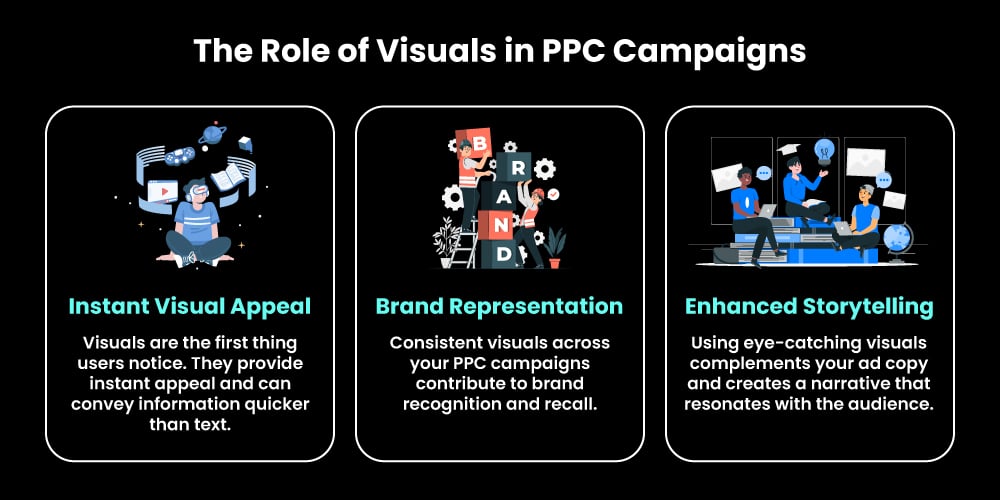
Tips for Creating Eye-Catching Graphics that Complement Your Ad Copy
- Consistency is Key:
Maintain a consistent visual theme across all your PPC campaigns. Whether it’s color schemes, fonts, or style, consistency fosters a unified brand identity. - Prioritize Readability:
Ensure your graphics are easily readable, even at a glance. Choose legible fonts and use contrasting colors to make important information stand out. - Optimize for Multiple Platforms:
Graphics should be optimized for various platforms and devices. Ensure they maintain quality and clarity on both desktop and mobile screens. - Balance Text and Images:
Strike a balance between text and images. Avoid clutter and ensure that your graphics convey the core message without overwhelming the viewer.
Remember, the visuals in your PPC campaign are the visual ambassadors of your brand. Craft them with care, keeping your audience in mind, and let them play a pivotal role in the success of your PPC campaigns.
Also read: The Power of Visual Content Marketing
5. Campaign Setup and Types
In the intricate field of online advertising, setting up your PPC campaign is akin to laying the foundation for success. Let’s navigate through the crucial steps:
Select the Type of PPC Campaign
Choosing the right PPC campaign type is like selecting the right tool for the job. Here’s an overview of the most commonly used campaign types to help you make an informed decision:
Search Campaigns
Focus on search campaigns if your goal is to appear prominently in search engine results. It’s ideal for capturing users that are actively searching for specific keywords related to your offerings.
Display Campaigns
Display campaigns leverage visual ads across a network of websites. Perfect for brand visibility, these campaigns target users based on their interests, behaviors, and demographics.
Social Media Campaigns
Social campaigns thrive on platforms like Facebook, Instagram, Twitter, and LinkedIn. Tailor your approach based on the unique audience and engagement dynamics of each platform.
Video Campaigns
Video campaigns, often part of display or social, focus on engaging users through visual storytelling. It’s ideal for conveying complex messages or showcasing product features.
Shopping Campaigns
Perfect for e-commerce, shopping campaigns highlight specific products with images, prices, and details. Appearing in search results, they target users ready to make a purchase.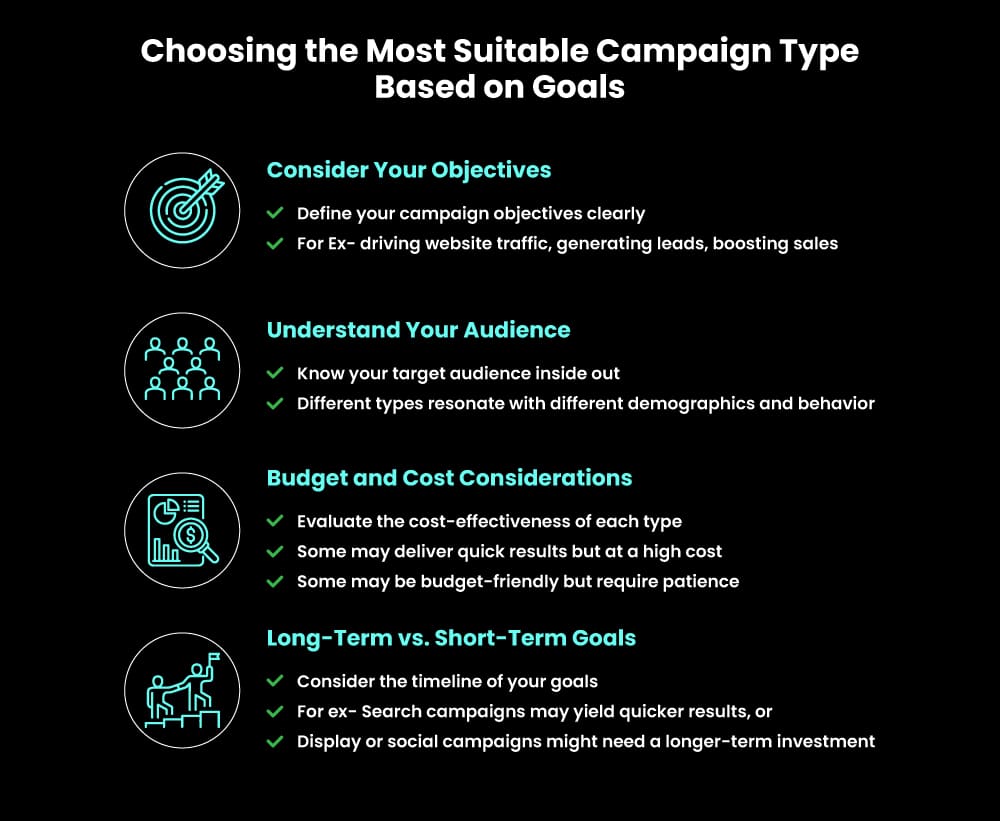
Selecting the right PPC campaign type sets the stage for a successful digital marketing journey. Dive deep into your goals, understand your audience, and align your budget to make an informed decision that propels your PPC campaign toward triumph.
6. Identify Optimal Platforms for Your PPC Campaigns
In the expansive field of digital advertising, pinpointing the optimal platforms for your PPC campaigns is pivotal. Let’s embark on the journey of platform selection:
Tailor Your Campaigns to the Strengths of Each Platform
Ad Formats and Creatives
Different platforms support various ad formats. Tailor your creatives to match the strengths of each platform, whether it’s engaging visuals on Instagram or concise text on Twitter.
Audience Targeting
Leverage the unique audience-targeting capabilities of each platform. Google Ads focuses on search intent, while Facebook and LinkedIn allow precise demographic and interest-based targeting.
Ad Placement
Consider where your ads will appear on each platform. Google Ads might place you in search results, while Facebook offers placements in the news feed or sidebar. Optimize for visibility.
Budget Allocation
Distribute your budget strategically across platforms based on their strengths and your campaign goals. Some platforms may require higher bids for competitive keywords or audience segments.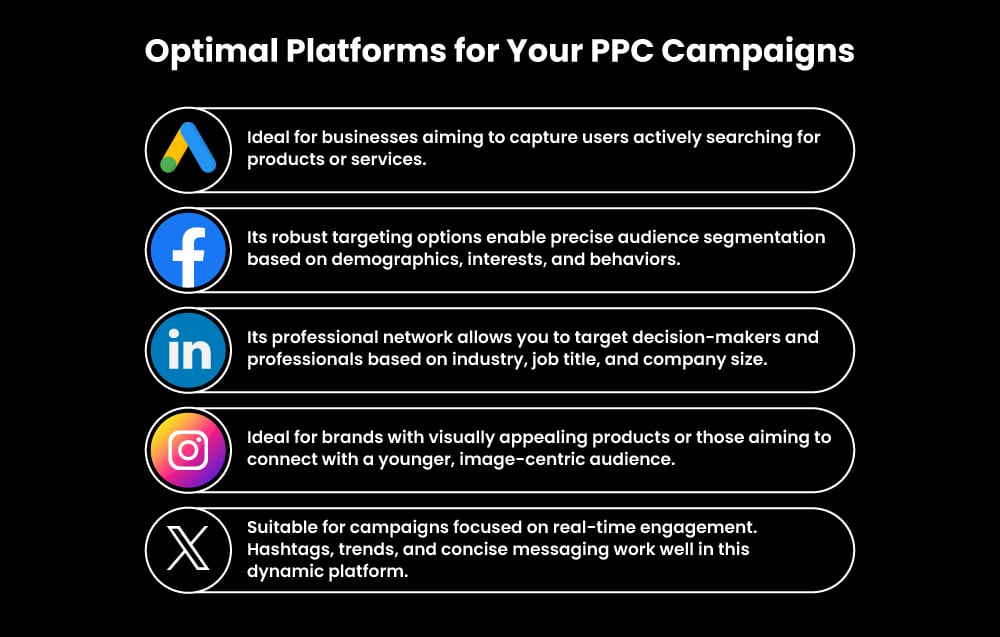
Identifying optimal platforms is about aligning your PPC campaign goals with the unique strengths of each channel. Evaluate the characteristics of Google Ads, Facebook, LinkedIn, and others to make informed decisions that maximize the impact of your PPC campaigns.
7. Create High-Converting Landing Pages
Crafting landing pages that convert is an art. Let’s explore the essential elements every landing page should have and discuss some valuable tips for optimization:
Key Elements Every Landing Page Should Have
Clear Value Proposition
Communicate your offering succinctly. Visitors should instantly understand what you’re providing and why it’s valuable to them.
Compelling Headline
Grab attention with a headline that resonates with your audience and aligns with your ad content.
Concise and Relevant Copy
Keep your copy clear, concise, and directly related to your offer. Avoid unnecessary fluff that may distract visitors.
Strategic Use of Visuals
Incorporate relevant images or videos that support your message and guide visitors through the content.
Prominent Call-to-Action (CTA)
Place a clear and prominent CTA button that directs visitors to take the desired action. Use compelling language that conveys urgency or benefit.
Mobile Responsiveness
Ensure your landing page is optimized for mobile devices. A seamless mobile experience is vital as a significant portion of users access content on smartphones.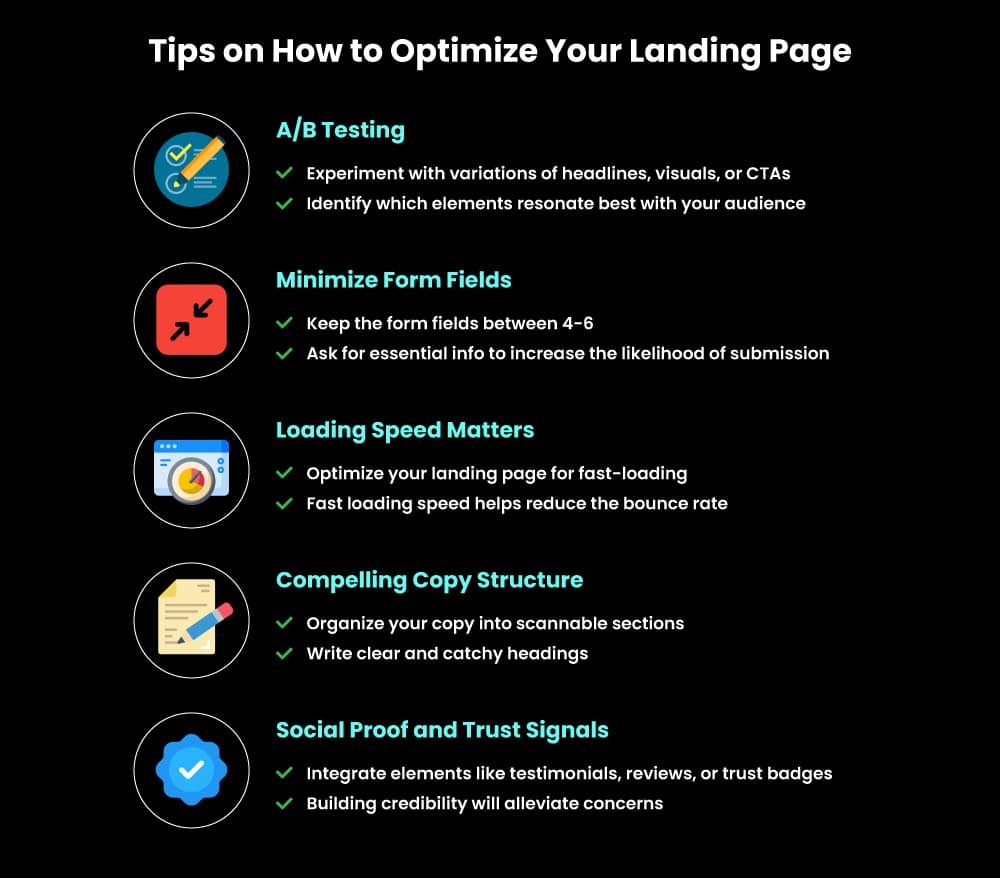
8. Bid Management
With the existence of fierce competition in the world of online advertising, how you manage your bids can make or break your PPC campaign. Let’s break down the basics of bidding and optimization:
8.1 Understanding the Bidding Process
Auction Dynamics: Think of PPC as an auction where advertisers bid for ad placements. Your bid amount, along with ad quality, plays a crucial role in where your ad appears.
Your Bid Amount:
This is how much you’re willing to pay for a click. Finding the sweet spot ensures competitiveness without blowing your budget.
Ad Rank:
Ad Rank decides your ad’s position. It’s a mix of your bid and your ad’s Quality Score. Even if your bid is lower, a high Ad Rank can boost visibility.
8.2 The Role of Quality Score in Bid Optimization
Quality Score Components:
Quality Score evaluates the relevance and quality of your ads. Components include ad relevance, expected click-through rate (CTR), and landing page experience.
Impact on Ad Rank:
A higher Quality Score positively influences your Ad Rank, allowing your ad to appear in a higher position with a potentially lower bid compared to competitors.
A higher Quality Score not only aids bid optimization but also contributes to the overall success of your PPC campaign.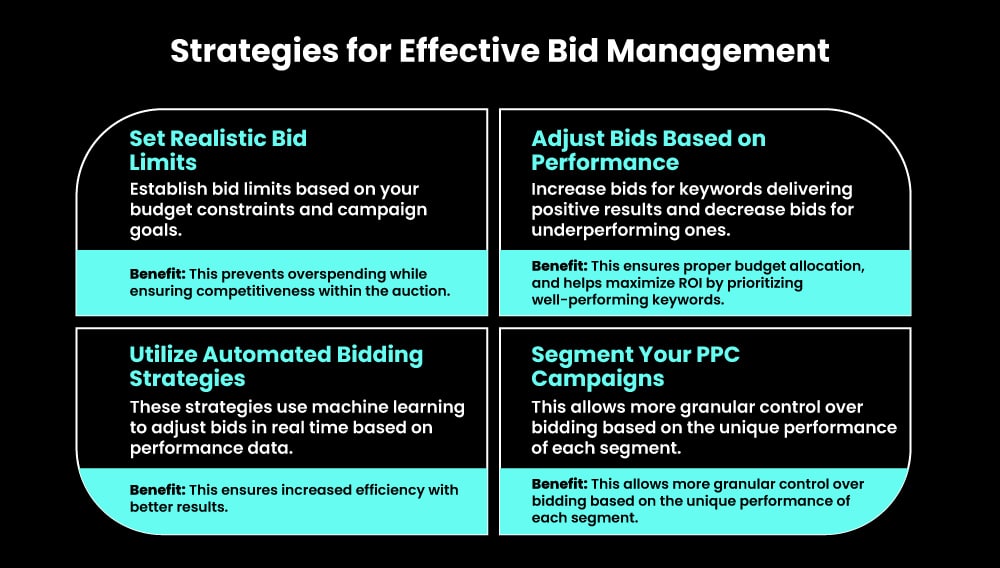
9. Effective Budget Allocation
Define Clear Goals: Prioritize your campaign goals, whether it’s traffic, leads, or sales, to guide your budget allocation strategy.
Research Industry Benchmarks: Understand average CPC and conversion rates in your industry to set realistic budget expectations.
Tailor Budget to Campaign Types: Adapt your budget strategy based on campaign types—more competitive for search campaigns and broader yet cost-effective for display campaigns.
Monitoring Return on Investment (ROI) and Adjusting Budget Accordingly
Track Conversions and Costs:
Keep a close eye on conversion metrics and costs. Understand the cost per acquisition (CPA) and ensure that your spending aligns with the value generated from conversions.
ROI Analysis:
Evaluate whether the revenue generated justifies the expenditure and adjust your budget based on the PPC campaigns delivering the best ROI.
Budget Reallocation:
If a particular channel or campaign is consistently underperforming, consider redistributing funds to higher-performing areas.
Budget allocation isn’t a set-it-and-forget-it task; it’s a dynamic process that requires constant evaluation and adjustment.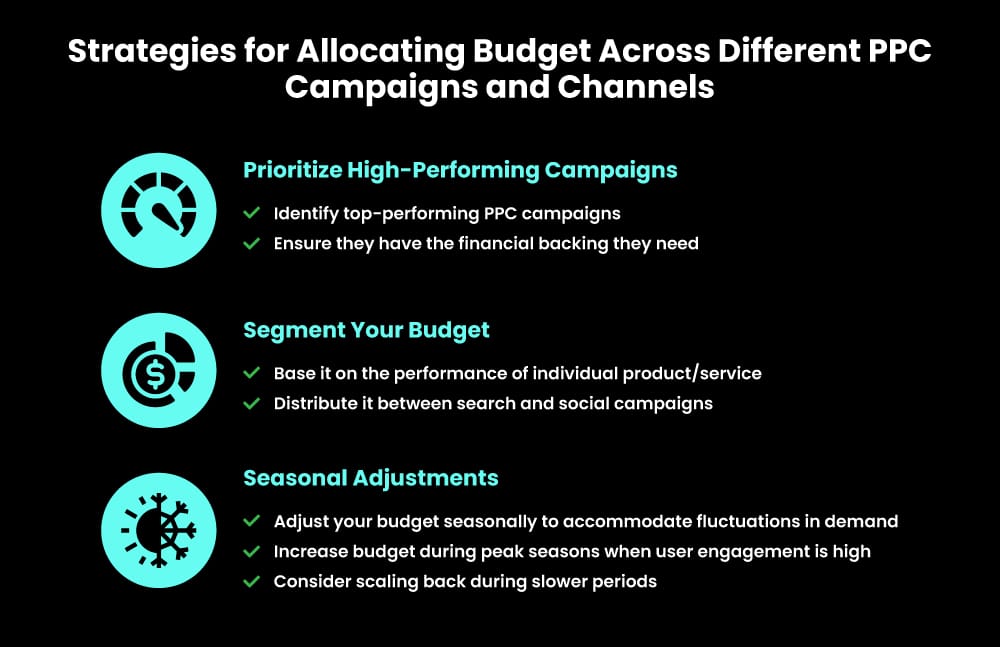
By aligning your budget with your goals, strategically dividing funds, and staying vigilant about ROI, you ensure that every dollar invested contributes to the success of your PPC campaigns.
10. Monitoring and Optimization
Constant monitoring and strategic optimization are the keys to ensuring successful PPC campaigns. Regularly keeping an eye on performance metrics and making smart adjustments ensure your campaigns stay on the right track.
10.1 Setting Up Analytics Tools for Accurate Tracking
Choose the Right Tools
Select analytics tools that align with your campaign objectives. Platforms like Google Analytics or specialized PPC analytics tools offer robust features tailored to the intricacies of PPC tracking.
Implement Conversion Tracking
Set up conversion tracking to trace user actions that align with your campaign goals. This includes completed purchases, sign-ups, or any other desired conversions. Accurate conversion tracking is the bedrock of performance assessment.
Also read: How to Set Up Google Ads Enhanced Conversions With GTM [Just 3 Steps]
Link with PPC Platforms
Integrate analytics tools seamlessly with your PPC platforms. This integration provides a unified view, allowing you to correlate PPC efforts with user behavior and overall website engagement.
10.2 Key Performance Indicators (KPIs) to Monitor
- Click-through rate (CTR)
- Conversion Rate
- Cost Per Click (CPC)
- Return on Investment (ROI)
- Quality Score
Conclusion
You’ve just unlocked the playbook for PPC success, and it’s time to make these strategies work for you. As we wrap up our guide on effective strategies for creating successful PPC campaigns, keep in mind that these aren’t just ideas—they’re practical tools ready for action.
In the ever-changing digital world, those who adapt and try new things come out on top. Stay curious, experiment a little, pay attention to the data, or get help from Our PPC experts if you want sure results. Mastering PPC is an ongoing journey, and every tweak you make brings you closer to campaign success.
So, go ahead, put these strategies to work, and watch your PPC campaigns transform. Your audience is waiting, ready to engage with what you have to offer. Take the chance, and let your PPC efforts shine online. Happy campaigning!
Also read: Learn How to Save Time and Money on Google Ads With This Ultimate Guide to Google Ads Editor
Until next time.


This is my first time pay a quick visit at here and i am really happy to read everthing at one place
“Insightful article! The step-by-step approach to building a PPC campaign strategy is practical and easy to follow. Great tips for creating campaigns that truly engage the audience!”
Well-organized and informative, presenting the content in a structured manner that enhances reader comprehension.
Insightful with practical examples, demonstrating how theoretical ideas can be implemented in real-world situations.
I love how this blog covers a variety of topics, making it appeal to a diverse audience There is something for everyone here!
Your blog post was fantastic, thanks for the great content!
Thank you for the amazing blog post!
Your photography and visuals are always so stunning They really add to the overall quality of the content
It’s always a joy to stumble upon content that genuinely makes an impact and leaves you feeling inspired. Keep up the great work!
Your blog post was really enjoyable to read, and I appreciate the effort you put into creating such great content. Keep up the great work!
I appreciate how well-researched and informative each post is It’s obvious how much effort you put into your work